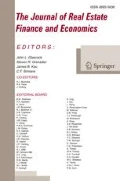Abstract
The behaviour of real estate markets during the 1997–98 Financial crisis in Asian economies has received little attention despite the extensive research on other asset markets over this time. This paper examines the transmission of shocks across national real estate markets prior to and during the Asian crisis using a multivariate latent factor framework. The results reveal that diversification opportunities prior to the crisis are much reduced during the crisis. A comparison with regional equity markets shows that the transmission of shocks differs across the real estate and equity markets, providing evidence that investment in multiple asset classes provides some protection from large market downturns.
Similar content being viewed by others
References
Bae KH, Karolyi GA, Stulz RM (2003) A new approach to measuring financial contagion. Rev Financ Stud 16(3):717–763
Baig T, Goldfajn I (1999) Financial market contagion in the asian crisis. IMF Staff Pap 46(2):167–195
Bekaert G, Harvey CR, Ng A (2005) Market integration and contagion. J Bus 78(1):39-69
Bond SA, Karolyi A, Sanders A (2003) International real estate returns a multifactor, multicountry approach, Real Estate Econ 31(3):481–500
Bond SA, Patel K (2003) The conditional distribution of real estate returns: are higher moments time varying, J Real Estate Finance Econ 26:319–339
Bond SA, Hwang S (2004) Liquidity risk and real estate: a quantitative approach to assessing risk, paper presented to the 2004 European Real Estate Society annual meeting. Milan, June 2004
Butler KC, Joaquin DC (2002) Are the gains from international portfolio diversification exaggerated? The influence of downside risk in bear markets? J Int Money Financ 21:981–1011
Debelle E, Ellis L (2005) The response of financial markets in Australia and New Zealand to news about the Asian crisis. In: M Dungey, D. Tambakis (eds) Identifying international financial contagion: progress and challenges. Oxford University Press, New York, pp 150–187
De Wit I, Dijk R van (2003) The global determinants of direct office real estate returns. J Real Estate Finance Econ 26(1):27–45
Diebold FX, Nerlove M (1989) The dynamics of exchange rate volatility: a multivariate latent-factor ARCH model. J App Econ 4:1–22
Dornbusch R, Park YC, Claessens S (2000) Contagion: understanding how it spreads. World Bank Res Obs 15(2):177–197
Duffie D, Singleton K (1993) Simulated moments estimator of Markov Models of asset prices. Econometrica July, 61(4):929–962
Dungey M, Martin VL (2001) Contagion across financial markets: an empirical assessment. New York Stock Exchange Conference Paper, February 16–17, 2001, Hawaii
Dungey M, Fry R, Gonzālez-Hermosillo B, Martin VL (2005a) Empirical models of contagion: a review of the methodologies, Quantitative Finance 5:1–16
Dungey M, Fry R, Gonzālez-Hermosillo B, Martin VL (2005b) A comparison of alternative tests of contagion with applications. In: M Dungey, D Tambakis (eds) Identifying international financial contagion: progress and challenges. Oxford University Press, New York, pp 60–85
Eichengreen B, Rose AK, Wyplosz C (1995) Exchange market mayhem: the antecedents and aftermath of speculative attacks. Econ Policy 21:249–312
Eichengreen B, Rose AK, Wyplosz C (1996) Contagious currency crises, NBER Working Paper, 5681.
Fama E, French K (1996) Multifactor explanations of asset pricing anomolies. J Finance 51(1):55– 84
Favero CA, Giavazzi F (2002) Is the international propagation of financial shocks non-linear? Evidence from the ERM. J Int Econ 57(1):231–246
Flood R, Rose AK (2004) Equity integration in times of crisis. In: Borio, Hunter, Kaufman, Tsatsanoris (eds) Market discipline. MIT Press
Forbes K, Rigobon R (2001) Measuring contagion, conceptual and empirical issues. In: S. Claessens, K. Forbes (eds) International financial contagion. Kluwer Academic Publishers
Forbes K, Rigobon R (2002) No contagion, only interdependence: measuring stock market comovements. J Finance 57(5):2223–2261
Gallant AR, Tauchen F (1996) Which moments to match? Econom Theory 12(4):657–681
Glascock JL, Lu C, So R (2000) Further evidence on the integration of REIT, bond and stock returns. J Real Estate Finance Econ 20:177–194
Gourieroux C, Monfort A, Renault E (1993) Indirect inference. J Appl Econ 8:S85–S118
erring R, Wachter S (1999) Real estate booms and banking busts: an international perspective. Wharton Working Paper Series, pp 99–27
Hong Kong Monetary Authority (1998) Hong Kong Monetary Authority Annual Report 1998. Hong Kong
Kallberg JG, Liu CH, Pasquariello P (2002) Regime shifts in Asian equity and real estate markets. Real Estate Econ 30(2):263–291
Kaminsky GL, Reinhart CM (2003) The center and the periphery: tales of financial turmoil. NBER Working Paper 9479
King M, Wadhwani S (1990) Transmission of volatility between stock markets. Rev Financ Stud 3(1):5–33
Lowenstein R (2001) When genius failed: the rise and fall of long term capital management. 4th Estate, UK
Mahieu R, Schotman P (1994) Neglected common factors in exchange rate volatility. J Empir Finance 1:279–311
Masson P (1999) Contagion: macroeconomic models with multiple equilibria. J Int Money Finance 18:587–602
McKibbin W, Martin W (1998) The East Asian crisis: investigating causes and policy responses. Australian National University Working Paper in Trade and Development, 98/6
Mei J, Hu J (2000) Conditional risk premiums of asian real estate stocks. J Real Estate Finance Economics 21(3):297–313
Mera K, Renaud B (eds) (2000) Asia_s financial crisis and the role of real estate. M.E. Sharpe. New York,
Pericoli M, Sbracia M (2003) A primer on financial contagion. J Econ Surv 17(4):571–608
Pesaran H, PickA(2003) Econometric issues in the analysis of contagion. CESifo Working Paper 1176
The Economist (1997a) A rubbery sort of economy. Economist Nov 1, 1997, 345(8041):78–79
The Economist (1997b) Safe harbour no more. Economist Oct 25, 1997, 345(8040):79–80
The Economist (1998) Finance and Economics: Market Force, Economist Aug 22, 1998, 348(8082):57–58
Author information
Authors and Affiliations
Corresponding author
Rights and permissions
About this article
Cite this article
Bond, S.A., Dungey, M. & Fry, R. A Web Of Shocks: Crises Across Asian Real Estate Markets. J Real Estate Finan Econ 32, 253–274 (2006). https://doi.org/10.1007/s11146-006-6800-0
Published:
Issue Date:
DOI: https://doi.org/10.1007/s11146-006-6800-0




